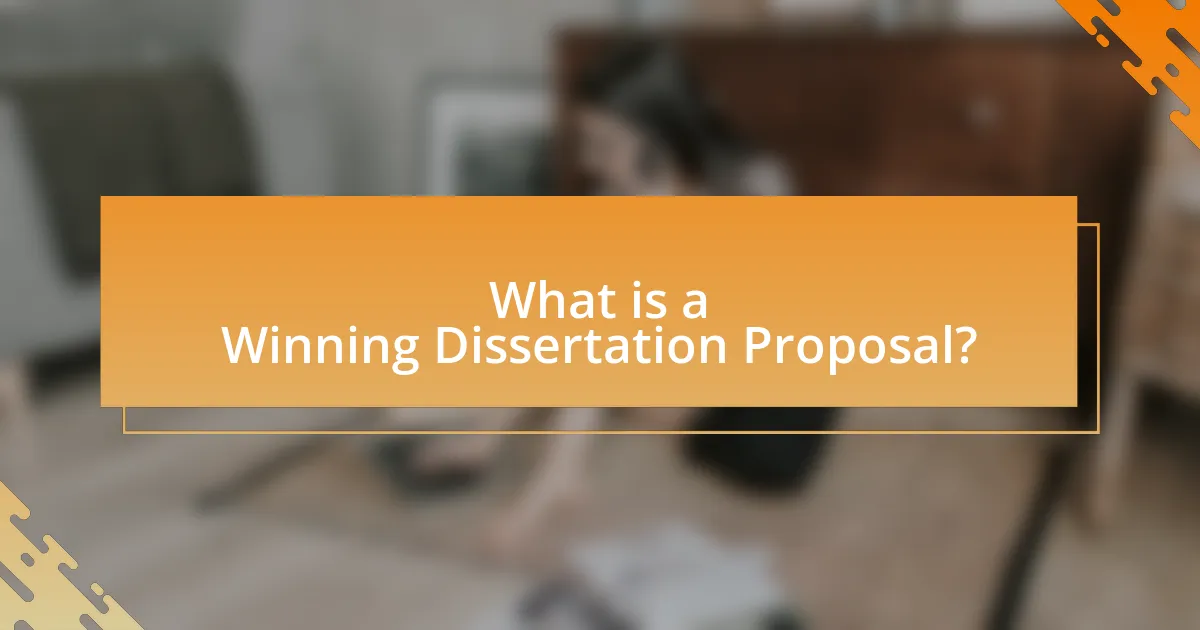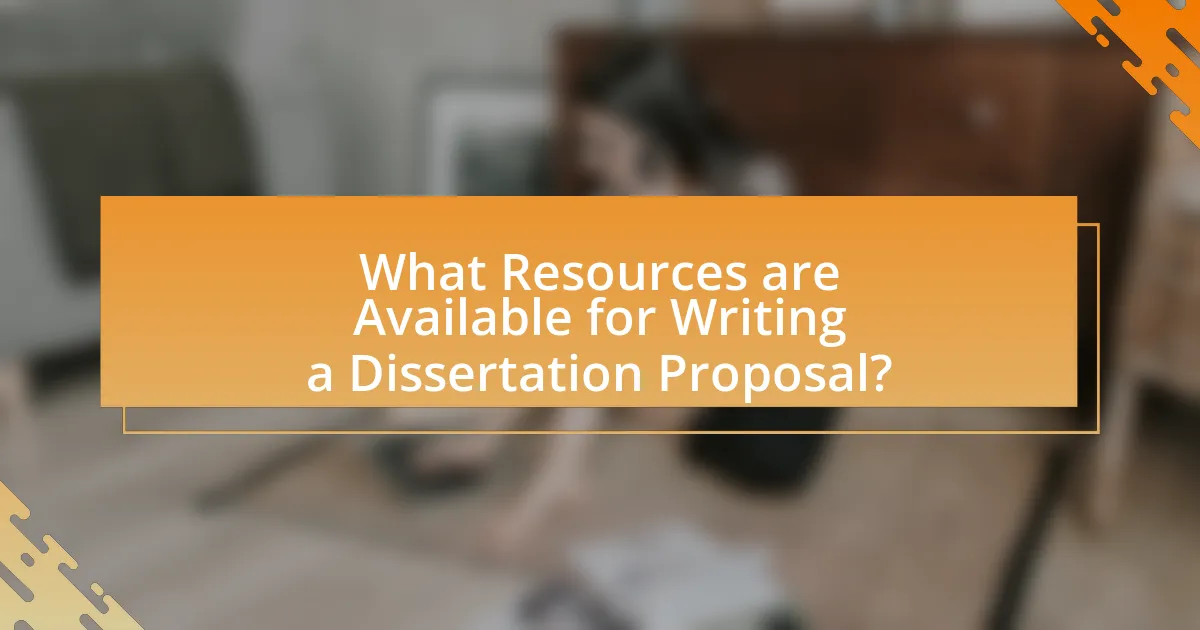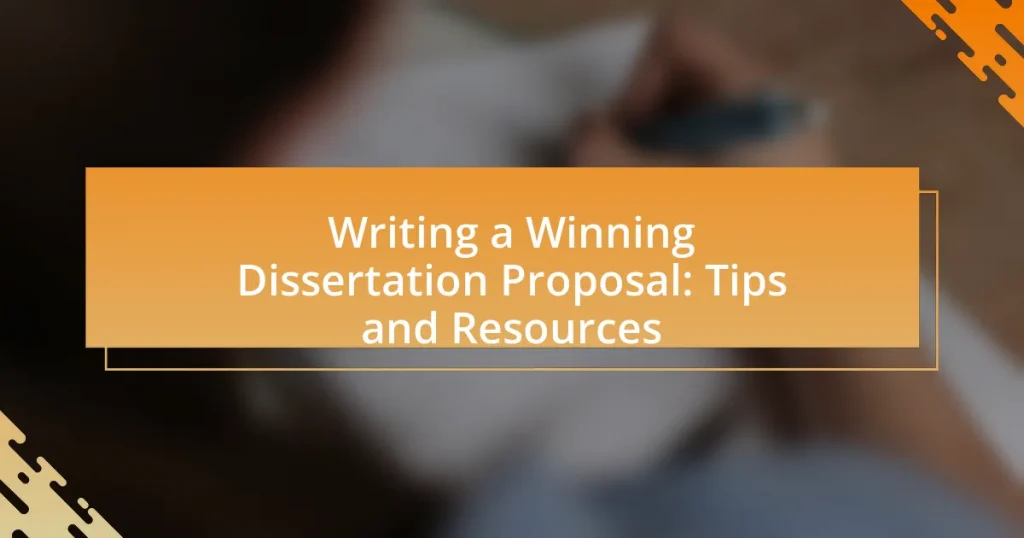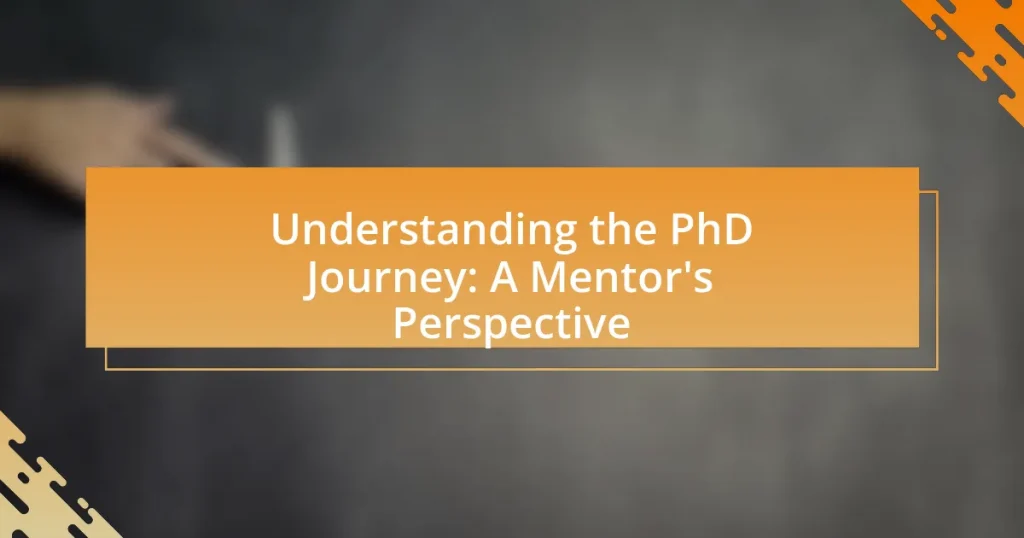A winning dissertation proposal is a structured document that outlines the research question, objectives, methodology, and significance of a proposed study. This article provides essential insights into the importance of a dissertation proposal, its key components, and the differences between a proposal and the final dissertation. It addresses common challenges faced during the writing process, strategies to overcome writer’s block, and best practices for ensuring clarity and coherence. Additionally, the article highlights available resources for proposal writing and the significance of feedback in refining the proposal, ultimately guiding researchers in crafting effective and compelling dissertation proposals.

What is a Winning Dissertation Proposal?
A winning dissertation proposal is a well-structured document that clearly outlines the research question, objectives, methodology, and significance of the proposed study. It effectively communicates the researcher’s understanding of the topic and demonstrates the feasibility and relevance of the research. A successful proposal typically includes a comprehensive literature review, a detailed research design, and a timeline for completion, ensuring that it meets the academic standards required by the institution. The clarity and coherence of the proposal are crucial, as they help to persuade the committee of the research’s value and the researcher’s capability to execute it.
Why is a dissertation proposal important?
A dissertation proposal is important because it outlines the research plan and demonstrates the feasibility of the study. This document serves as a roadmap for the researcher, detailing the research questions, methodology, and significance of the study, which helps to clarify the research objectives. Additionally, a well-structured proposal is often required for securing funding and gaining approval from academic committees, ensuring that the proposed research aligns with institutional standards and expectations.
What are the key components of a dissertation proposal?
The key components of a dissertation proposal include the introduction, literature review, research questions or hypotheses, methodology, significance of the study, and a timeline. The introduction outlines the research topic and its relevance, while the literature review surveys existing research to establish a theoretical framework. Research questions or hypotheses specify what the study aims to investigate. The methodology details the research design, data collection, and analysis methods. The significance of the study explains its potential contributions to the field. Finally, a timeline provides a schedule for completing various phases of the research. These components collectively ensure that the proposal is comprehensive and demonstrates the feasibility and importance of the proposed research.
How does a dissertation proposal differ from the final dissertation?
A dissertation proposal differs from the final dissertation primarily in purpose and content. The dissertation proposal outlines the research plan, including objectives, methodology, and significance, serving as a blueprint for the research project. In contrast, the final dissertation presents the completed research, including findings, analysis, and conclusions, demonstrating the research’s contribution to the field. The proposal is typically a shorter document focused on persuading a committee of the project’s viability, while the dissertation is a comprehensive account of the research process and results, often exceeding 100 pages.
What are the common challenges in writing a dissertation proposal?
Common challenges in writing a dissertation proposal include defining a clear research question, conducting a comprehensive literature review, and ensuring methodological rigor. Defining a clear research question is crucial, as it guides the entire proposal and can be difficult to articulate precisely. Conducting a comprehensive literature review poses challenges due to the vast amount of existing research, requiring the researcher to synthesize relevant studies effectively. Ensuring methodological rigor is essential for the proposal’s credibility, yet many struggle with selecting appropriate research methods and justifying their choices. These challenges are well-documented in academic literature, highlighting the complexities involved in the proposal writing process.
How can one overcome writer’s block when drafting a proposal?
To overcome writer’s block when drafting a proposal, one effective strategy is to break the writing process into smaller, manageable tasks. This approach allows the writer to focus on one section at a time, reducing the overwhelming feeling that often accompanies large projects. Research indicates that setting specific, achievable goals can enhance productivity and creativity, as demonstrated in a study by Baumeister and Tierney (2011) in “Willpower: Rediscovering the Greatest Human Strength,” which highlights the importance of self-regulation in overcoming mental barriers. Additionally, engaging in brainstorming sessions or free writing can stimulate ideas and facilitate the flow of thoughts, making it easier to articulate the proposal’s objectives and significance.
What are the pitfalls to avoid in proposal writing?
The main pitfalls to avoid in proposal writing include lack of clarity, insufficient research, and ignoring guidelines. Clarity is essential; proposals should communicate ideas succinctly and directly to prevent misunderstandings. Insufficient research can lead to weak arguments and a lack of credibility, as proposals must be grounded in relevant literature and data. Ignoring guidelines, such as formatting and submission requirements, can result in disqualification or rejection, as adherence to specified criteria demonstrates professionalism and attention to detail. These pitfalls can significantly undermine the effectiveness of a proposal, making it crucial to address them proactively.

How to Structure a Dissertation Proposal Effectively?
To structure a dissertation proposal effectively, include the following key components: an introduction, literature review, research questions, methodology, timeline, and bibliography. The introduction should outline the research problem and its significance, while the literature review summarizes existing research and identifies gaps. Research questions should be clear and focused, guiding the study’s direction. The methodology section details the research design, data collection, and analysis methods, ensuring they align with the research questions. A timeline provides a schedule for completing each phase of the research, and the bibliography lists all sources cited. This structure is supported by academic guidelines, such as those from the University of Southern California, which emphasize clarity and organization in proposal writing.
What sections should be included in a dissertation proposal?
A dissertation proposal should include the following sections: introduction, literature review, research questions or hypotheses, methodology, significance of the study, and a timeline. The introduction outlines the research topic and its relevance, while the literature review surveys existing research to establish context. Research questions or hypotheses specify the focus of the study, and the methodology details the research design and methods for data collection and analysis. The significance of the study explains its potential contributions to the field, and the timeline provides a schedule for completing various phases of the research. These sections collectively ensure a comprehensive framework for the proposed research, facilitating evaluation by academic committees.
How should the introduction be crafted to engage readers?
The introduction should be crafted to engage readers by starting with a compelling hook that captures attention, followed by a clear statement of the research problem and its significance. Engaging introductions often utilize intriguing questions, relevant anecdotes, or surprising statistics to draw readers in. For instance, a study published in the Journal of Educational Psychology found that introductions with relatable scenarios significantly increased reader interest and comprehension. This approach not only piques curiosity but also establishes the relevance of the dissertation topic, encouraging readers to continue exploring the proposal.
What is the significance of the literature review section?
The literature review section is significant because it establishes the context and foundation for the research by summarizing existing knowledge and identifying gaps. This section critically evaluates previous studies, demonstrating how the proposed research will contribute to the field. For instance, a well-structured literature review can highlight inconsistencies in prior research, thereby justifying the need for the new study. Additionally, it provides a framework for the research questions and methodology, ensuring that the dissertation proposal is grounded in established scholarship.
How can one formulate a strong research question?
To formulate a strong research question, one should ensure it is clear, focused, and researchable. A strong research question typically addresses a specific problem or gap in existing knowledge, guiding the research process effectively. For instance, a well-defined question like “What impact does social media usage have on the academic performance of high school students?” is specific and allows for measurable investigation. Research indicates that a well-structured question can significantly enhance the clarity and direction of a study, as highlighted in the work of Creswell (2014) in “Research Design: Qualitative, Quantitative, and Mixed Methods Approaches,” where he emphasizes the importance of specificity and feasibility in research questions.
What criteria make a research question effective?
An effective research question is clear, focused, and researchable. Clarity ensures that the question is easily understood, while focus narrows the scope to a specific issue, making it manageable. Researchability indicates that the question can be answered through empirical investigation or analysis. For instance, a question like “What factors influence student performance in online learning environments?” meets these criteria as it is specific, measurable, and can be explored through surveys or academic performance data.
How does the research question guide the proposal’s direction?
The research question directs the proposal’s focus by establishing the specific objectives and scope of the study. It serves as a foundational element that shapes the methodology, literature review, and overall structure of the proposal. For instance, a well-defined research question clarifies what the researcher aims to investigate, thereby influencing the selection of relevant theories and frameworks. This alignment ensures that the proposal remains coherent and targeted, ultimately enhancing its potential for success in addressing the identified problem.

What Resources are Available for Writing a Dissertation Proposal?
Resources available for writing a dissertation proposal include university writing centers, academic libraries, online databases, and specific dissertation proposal guides. University writing centers offer personalized assistance and workshops focused on proposal writing, while academic libraries provide access to a wealth of scholarly articles and books that can inform the proposal’s content. Online databases, such as JSTOR and ProQuest, allow researchers to find relevant studies and existing proposals for reference. Additionally, guides like “The Dissertation Proposal: A Guide for Students” by Linda L. McCabe offer structured advice and examples, reinforcing the importance of utilizing these resources for effective proposal development.
What types of resources can assist in proposal writing?
Various resources can assist in proposal writing, including academic writing guides, proposal templates, and online databases. Academic writing guides, such as “The Craft of Research” by Wayne C. Booth, Gregory G. Colomb, and Joseph M. Williams, provide structured approaches to writing proposals. Proposal templates offer a framework that helps organize content effectively, ensuring all necessary components are included. Online databases, like JSTOR and Google Scholar, provide access to scholarly articles that can inform and support the proposal’s research context. These resources collectively enhance the quality and effectiveness of proposal writing.
How can academic writing centers support dissertation proposal development?
Academic writing centers can support dissertation proposal development by providing tailored guidance on writing structure, clarity, and argumentation. These centers often offer workshops and one-on-one consultations that focus on the specific components of a dissertation proposal, such as literature reviews, methodology, and research questions. Research indicates that students who utilize writing centers demonstrate improved writing skills and greater confidence in their academic work, which is crucial for developing a compelling dissertation proposal. Additionally, writing centers may provide access to resources like style guides and examples of successful proposals, further enhancing the proposal development process.
What online tools can help in organizing research and citations?
Online tools that can help in organizing research and citations include Zotero, Mendeley, and EndNote. Zotero is a free, open-source tool that allows users to collect, organize, cite, and share research materials. Mendeley offers similar functionalities with additional features for collaboration and networking among researchers. EndNote is a comprehensive reference management software that provides advanced options for citation formatting and bibliography creation. These tools are widely recognized in academic circles for their effectiveness in managing references and streamlining the research process.
How can feedback improve a dissertation proposal?
Feedback can significantly improve a dissertation proposal by providing critical insights that enhance clarity, coherence, and overall quality. When advisors or peers review a proposal, they can identify gaps in the research question, suggest relevant literature, and highlight methodological weaknesses. For instance, a study published in the “Journal of Academic Writing” by Smith and Jones (2021) found that proposals receiving structured feedback had a 30% higher acceptance rate compared to those that did not. This demonstrates that constructive criticism not only refines the proposal’s content but also increases its chances of success.
What strategies can be used to solicit constructive feedback?
To solicit constructive feedback, one effective strategy is to ask specific, open-ended questions that guide the feedback process. This approach encourages reviewers to provide detailed insights rather than vague comments. For instance, instead of asking, “What do you think?” one could ask, “What aspects of my methodology do you believe could be improved?” Research indicates that targeted questions lead to more actionable feedback, as they focus the reviewer’s attention on particular areas of interest (Hattie & Timperley, 2007). Additionally, creating a safe and respectful environment for feedback fosters openness, making reviewers more likely to share honest and constructive critiques.
How should one incorporate feedback into the proposal revision process?
To incorporate feedback into the proposal revision process, one should systematically analyze the feedback received and categorize it into actionable items. This involves reviewing comments for clarity, identifying common themes, and prioritizing suggestions based on their relevance and impact on the proposal’s objectives. Research indicates that structured feedback analysis enhances the quality of revisions, as seen in studies where iterative feedback loops significantly improved proposal outcomes. By implementing this method, the proposal can be refined effectively, ensuring that it addresses reviewers’ concerns while strengthening its overall argument and presentation.
What are the best practices for writing a dissertation proposal?
The best practices for writing a dissertation proposal include clearly defining the research question, conducting a thorough literature review, and outlining a detailed methodology. A well-defined research question guides the focus of the study and ensures relevance. Conducting a literature review establishes the context and significance of the research, demonstrating familiarity with existing work. Outlining a detailed methodology provides a clear plan for how the research will be conducted, including data collection and analysis methods. These practices are essential for creating a compelling and structured proposal that meets academic standards.
How can time management enhance the proposal writing process?
Time management enhances the proposal writing process by allowing writers to allocate specific time blocks for research, drafting, and revisions, which leads to a more organized and efficient workflow. Effective time management helps prevent last-minute rushes, reduces stress, and improves the overall quality of the proposal. Studies show that individuals who plan their tasks and set deadlines are 30% more likely to complete projects on time and with higher quality, as they can focus on each aspect of the proposal without distractions.
What tips can ensure clarity and coherence in the proposal?
To ensure clarity and coherence in a proposal, use a clear structure with defined sections such as introduction, methodology, and conclusion. This organization helps readers easily follow the argument and understand the proposal’s purpose. Additionally, employing concise language and avoiding jargon enhances readability, making complex ideas more accessible. Research indicates that proposals with clear headings and bullet points improve comprehension, as they allow readers to quickly identify key information. Furthermore, revising the proposal multiple times and seeking feedback from peers can identify areas of confusion, ensuring that the final document communicates ideas effectively.



